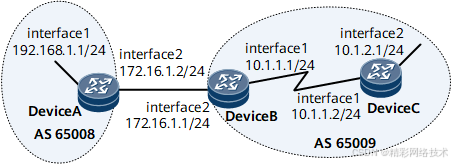学习精彩网络技术老师:华为HCIA和HCIP数通eNSP实战视频课、华三、锐捷、WLAN、IPv6等全套视频课程
配置BGP和IGP的交互,可以丰富协议路由表。
组网需求
通信业务的发展,要求能够在广泛的区域实现互访,并且数据传输可靠,中断时间短,这就要求路由的传播区域广,收敛速度快。BGP可以实现路由的高效广泛传播,但是BGP自身不会计算路由。IGP可以实现路由的快速收敛,但是IGP的路由传播效率低,范围小。配置BGP与IGP交互后,IGP路由可以被引入到BGP路由表进行高效广泛的传播,BGP路由也可以被引入到IGP路由表,实现对其他AS的访问。
如图1所示,用户将网络划分为AS65008和AS65009,在AS65009内,使用IGP协议来计算路由(该例使用OSPF做为IGP协议)。为了实现两个AS之间的互访,可以在AS之间配置BGP协议,在AS边缘NE上配置BGP与IGP交互,这样既可以利用BGP高效的把路由传递到其他AS,也可以把AS外部的路由引入到IGP,实现对AS外部的访问。

本例中interface1,interface2分别代表GE0/1/0,GE0/2/0。
配置思路
采用如下的思路配置BGP与IGP交互:
在DeviceB和DeviceC上配置OSPF协议。
在DeviceA和DeviceB上配置EBGP连接。
在DeviceB上配置BGP与OSPF互相引入,查看路由信息。
在DeviceB上配置BGP路由聚合,简化BGP路由表。
数据准备
为完成此配置例,需准备如下的数据:
DeviceA的Router ID以及所在AS号。
DeviceB、DeviceC的Router ID以及所在AS号。
操作步骤
- 配置各接口的IP地址(略)
- 配置OSPF
# 配置DeviceB。
[~DeviceB] ospf 1
[*DeviceB-ospf-1] area 0
[*DeviceB-ospf-1-area-0.0.0.0] network 10.1.1.0 0.0.0.255
[*DeviceB-ospf-1-area-0.0.0.0] commit
[~DeviceB-ospf-1-area-0.0.0.0] quit
[~DeviceB-ospf-1] quit
# 配置DeviceC。
[~DeviceC] ospf 1
[*DeviceC-ospf-1] area 0
[*DeviceC-ospf-1-area-0.0.0.0] network 10.1.1.0 0.0.0.255
[*DeviceC-ospf-1-area-0.0.0.0] network 10.1.2.0 0.0.0.255
[*DeviceC-ospf-1-area-0.0.0.0] commit
[~DeviceC-ospf-1-area-0.0.0.0] quit
[~DeviceC-ospf-1] quit
- 配置EBGP连接
# 配置DeviceA。
[~DeviceA] bgp 65008
[*DeviceA-bgp] router-id 1.1.1.1
 BGP与IGP交互配置示例
BGP与IGP交互配置示例





 最低0.47元/天 解锁文章
最低0.47元/天 解锁文章


















 936
936

 被折叠的 条评论
为什么被折叠?
被折叠的 条评论
为什么被折叠?










